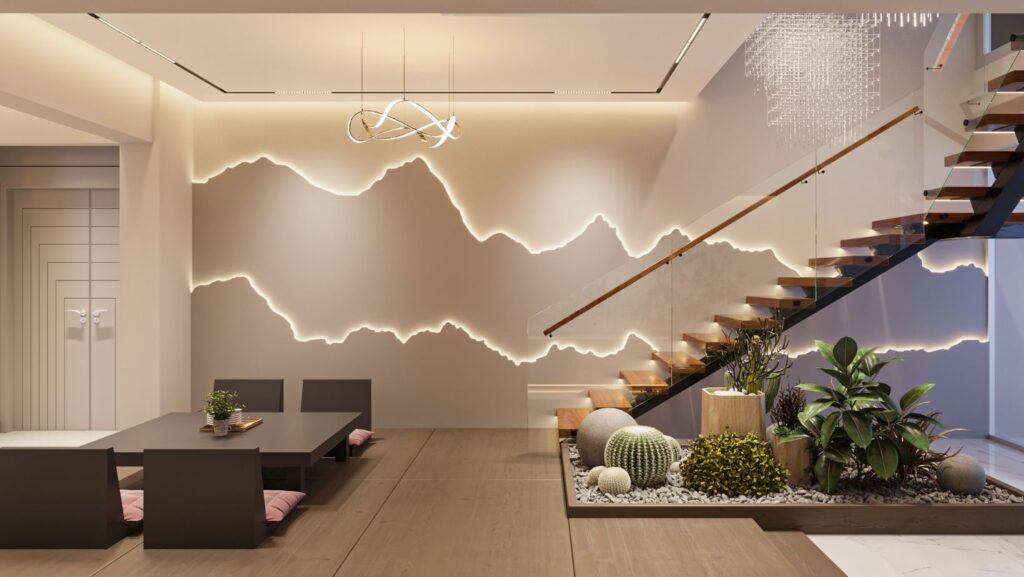In our fast-paced, ever-changing world, creating a calming environment has become essential for supporting mental wellbeing. The spaces we inhabit play a significant role in influencing our mood, productivity and sense of peace. Thoughtful design can transform a chaotic space into a sanctuary of tranquillity.
Neutral Colour Palettes
The choice of colors in a space can have a profound impact on our emotions. Neutral color palettes, such as soft whites, beiges, and light greys, create a serene backdrop that promotes relaxation. These colors are unobtrusive and provide a sense of openness and light, allowing your mind to rest. When combined with natural textures like wood and stone, neutral palettes can evoke a sense of harmony and balance.
Easy-to-Clean Design
Maintaining a clean and tidy space with minimal effort is crucial for reducing stress and promoting relaxation. Think about laminate, tile, or vinyl flooring, which are easier to clean and maintain than carpets due to their hard surfaces; they’re also more resistant to stains and wear. If you want durable fabrics such as leather that’s easy to clean, consider removable, washable covers as a convenient solution. Use air purifiers to help keep dust levels low; they help keep your windowsills and shelves clutter-free and make dusting quick and easy.
Natural Light
This is a powerful tool in creating a calming environment. It enhances mood, boosts productivity, and promotes a sense of well-being. Large windows, skylights, and open spaces allow natural light to flood into a room, reducing the need for artificial lighting. Consider sheer curtains that allow light to pass through while maintaining privacy. If natural light is limited, mirrors can be strategically placed to reflect and amplify the available light.
Balanced Lighting
Avoid harsh, direct lighting and instead use soft, diffused light sources. Think about table lamps, floor lamps, and wall sconces with adjustable brightness levels to create a warm and inviting atmosphere. Consider using warm white bulbs instead of cool white to enhance the coziness.
Indoor Plants
Bringing nature indoors is an effective way to enhance tranquillity. Indoor plants not only purify the air, but they also add a touch of greenery that can reduce stress and improve concentration. Choose low-maintenance plants like succulents, snake plants or peace lilies.

The act of caring for plants can also be therapeutic; providing a calming routine that connects you with nature.
Minimalist Design
Clutter can be a significant source of stress. Adopting a minimalist design approach helps to cut unnecessary items; creating a clean, organised home. Focus on quality over quantity, choosing furniture and décor that are functional as well as aesthetically pleasing. Open shelving, hidden storage and multi-purpose furniture can help support an uncluttered environment.
Soft Textures
Incorporating soft textures into your design can add a sense of warmth and comfort. Choose floor rugs like plush rugs, cozy blankets, and soft cushions to invite relaxation and unwinding. Natural materials like cotton, wool, and linen aren’t just tactile; they’re also breathable, which enhances the overall comfort of your space.
Soothing Scents
Aromatherapy can significantly influence mood and relaxation. Incorporate soothing scents through candles, essential oils, or diffusers. Lavender, chamomile, and eucalyptus are known for their calming properties. Place them in strategic areas such as the living room, bedroom, or bathroom to create a consistent ambiance of tranquillity.
Water Features
The sound of flowing water is inherently soothing. Think about incorporating water features such as fountains, aquariums or even a small tabletop water element to bring a sense of calm to your space. The gentle sound of water can mask background noise and provide a peaceful auditory experience.
Decor
The artwork and décor you choose should resonate with your sense of peace and wellbeing. Find pieces that inspire calmness, such as serene landscapes, abstract art with soft colours or photographs of nature.

Make sure to avoid overly busy or aggressive patterns that can create visual chaos. Personalize your space with items that hold positive memories and sentiments.
Creating Your Peace
Designing a space that fosters calmness goes beyond aesthetics; it’s about creating an environment that nurtures your mind and spirit. By incorporating these ten design elements, you can transform your home into a sanctuary of tranquillity. Remember, the key is to create a space that reflects your personal sense of peace and comfort. Take the time to assess what makes you feel calm and happy, letting those insights guide your design choices.
